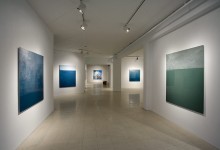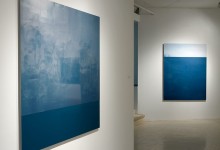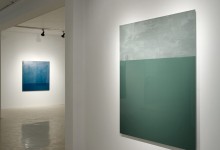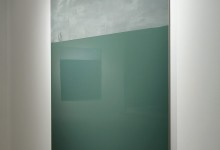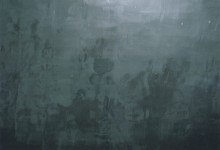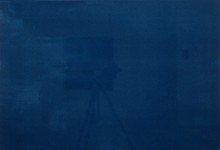Text by Marie-Ève Beaupré
Translation: Marie-Ève Deleris and Andria Hickey
On the surface of these enamelled paintings, our body finds itself disquieted by its own reflection. The works stare back at us, echoing our presence; what we are seeing is looking back at us. Standing in front of the paintings we first encounter this illusory plastic plenitude of monochrome. It is then replaced with a vertiginous sensation of space delineated by the pigmented surfaces. We are engaged in a destabilizing experience despite the apparent calmness of the images, simultaneously contemplative and active, gazing over the minimalist and ethereal landscapes and modifying the ghost of our own presence. If colour remains an enigma, then Venne’s painting becomes the embodiment of that enigma with each horizon line situating our contemplative gaze.
Taking landscape samples from photography, Henri Venne’s work is both an exploration of memory and a recollection of landscape. Even if the camera’s eye possesses persuasive descriptive capacities, it can only partially memorize atmosphere; the abstract sensations of light and the poetic grounds of an environment are often lost in the photographic reproduction. By superimposing painting and photography in his series enfermements colorés (coloured containments), Venne makes a powerful evocation of the primordial through his use of light and the absence of figuration. These images of time collect and are interwoven into a visual chiasmus. This accumulation is present sometimes on the aluminium panels, other times, under the pictorial layers, on the paper used for the numeric printing and under the enamel of the surface. The found photographic images and the reverberations inscribed on the lacquered skin of the paintings weave together the affective memory of the places evoked into the frame of the viewer.
Anchored in his present ponderings and exiled into lengthy contemplation, the work of Henri Venne results in a complex conception of painting which examines the physicality of each work, where surfaces, seemingly empty of figurative traces, evoke the infinite possibility of a poetic treatment of colours. Thus, in front of the evanescent quality of the images, the viewer hesitates between a contemplation of the coloured nothingness and the destabilization of an abstract and elusive image. Opening a dialogue between the idea of representation and the sensorial possibilities characteristic of formalist painting, Venne orchestrates a referential universe. It is as if the pigment and texture he uses is able to simulate a sort of archaeology of memory where we, as viewers before this reflective monochrome, also become inventors of meaning.



